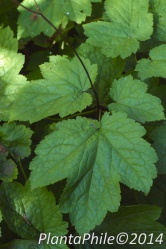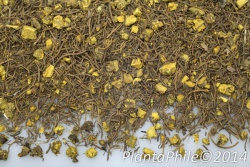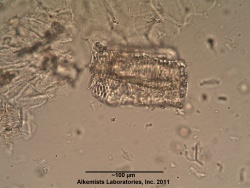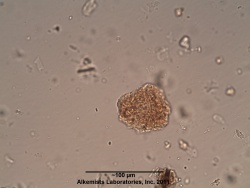|
AHPA recognizes other valuable resources exist regarding the identity of Hydrastis canadensis.
To submit a suggestion or contribution, please contact Merle Zimmermann.
|
Nomenclature
Hydrastis canadensis L. Ranunculaceae
Standardized common name (English): goldenseal
Botanical Voucher Specimen
 |
|
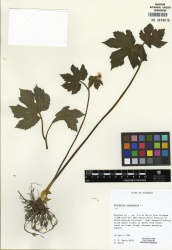
Source: MOBOT, Tropicos.org[1]
|
Organoleptic Characteristics
Macroscopic Characteristics
| Hydrastis canadensis is a small, herbaceous, perennial plant, with a thick, fleshy, yellow (rhizome, from which numerous long roots arise, and an erect, simple, pubescent stem, from six inches to a foot in height. There are usually but two leaves, which are unequal, one sessile at the top of the stem, the other attached to the stem, a short distance below by a thick roundish footstalk, causing the stem to appear as if bifurcate near the summit. The leaves are pubescent, roundish-cordate, with from three to seven, but generally five, lobes, which are pointed and unequally serrate. A solitary flower stands upon a peduncle rising from the basis of the upper leaf. It is without corolla, but with a greenish white calyx, the sepals of which closely resemble petals, and are very caducous, falling very soon after the flower has expanded. The fruit is a globose, compound, red or crimson berry, half an inch or more in diameter, composed of many fleshy carpels, each tipped with a short curved beak, and containing one or rarely two seeds.
Source: United States Dispensatory (1918) [2]
|
|
|
|
|
Microscopic Characteristics
High Performance Thin Layer Chromatographic Identification
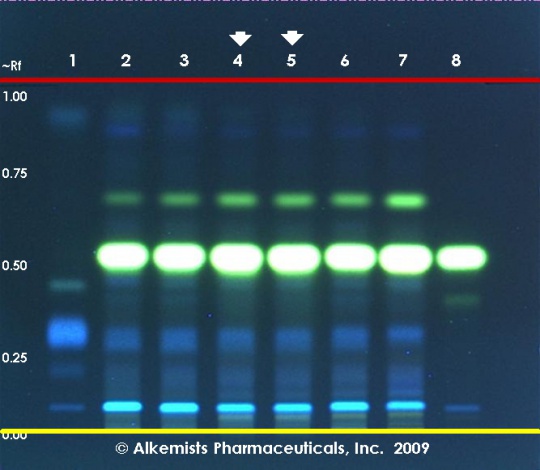
Hydrastis canadensis HPTLC ID - Ninhydrin Reagent UV 365 nm
Golden Seal (root) (Hydrastis canadensis)
Lane Assignments Lanes, from left to right (Track, Volume, Sample):
- 5 μL Hydrastine ~0.1% in Methanol
- 3 μL Hydrastis canadensis-1 (root)
- 3 μL Hydrastis canadensis-2 (root)
- 3 μL Hydrastis canadensis-3 (root)
- 3 μL Hydrastis canadensis-3 (root)
- 3 μL Hydrastis canadensis-4 (root)
- 3 μL Hydrastis canadensis-5 (root)
- 1 μL Berberine chloride ~0.1% in Methanol
Reference materials used here have been authenticated by macroscopic, microscopic &/or TLC studies according to the reference source cited below held at Alkemists Laboratories, Costa Mesa, CA.
Stationary Phase Silica gel 60, F254, 10 x 10 cm HPTLC plates
Mobile Phase ethyl acetate: methanol: HCOOH: water [10/2/1.2/0.6]
Sample Preparation Method 0.25g+4 ml 80% MeOH snct 1/2 hr cntrfg/dcnt, add 2mL MeOH, vrtx&cntrfg,dcnt&qs to 20mL w MeOH
Detection Method Ninhydrin Reagent -> UV 365 nm
Reference see American Herbal Pharmacopoeia & Therapeutic Compendium
Source: Elan M. Sudberg, Alkemist Laboratories [7]
|
Supplementary Information
Sources
- ↑ MOBOT, Tropicos.org http://www.tropicos.org/Image/100105541
- ↑ United States Dispensatory (1918)
- ↑ PlantaPhile http://plantaphile.com/
- ↑ PlantaPhile http://plantaphile.com/
- ↑ Elan M. Sudberg, Alkemist Laboratories http://www.alkemist.com
- ↑ Elan M. Sudberg, Alkemist Laboratories http://www.alkemist.com
- ↑ Elan M. Sudberg, Alkemist Laboratories http://www.alkemist.com



